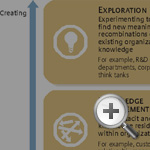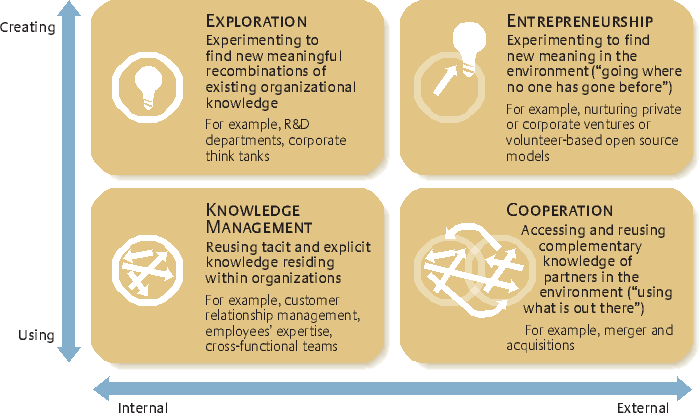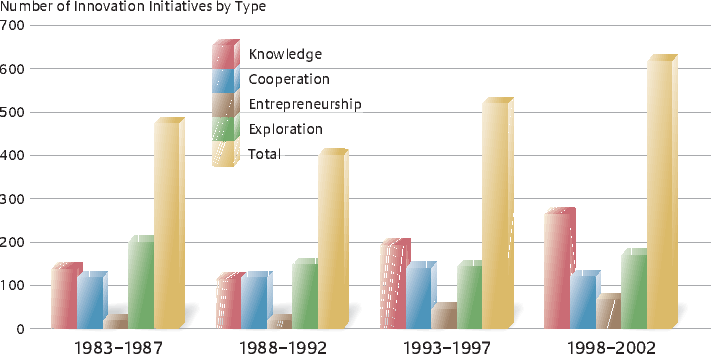The Link Between Diversity and Resilience
New research shows that the most resilient companies are those that continually orchestrate a dynamic balance of four innovation strategies.
Topics
Most managers and academics agree that innovation ensures superior performance. But which innovation strategy or strategies best sustain that performance over time? That is, how can companies manage innovation in order to become more resilient? Resilience is both an applicable and an important concept for companies in turbulent times.
The concept of resilience originates in research on child behavior,1 which indicates that some children prove to be positive, focused, flexible and proactive — in a word, resilient —despite exposure to extremely challenging and stressful environments.2 There are several ways of conceptualizing and adapting the basic idea of resilience to the business world. Some business writers have focused on corporate attributes, while others have focused on issues such as risk awareness, risk protection and the reduction of vulnerabilities.3 In strategic management, resilience has been defined as a process capability; in order to reinvent themselves, companies need to overcome barriers to change and develop multiple sources of competitive advantage.4 We define resilience as the capability to self-renew over time through innovation. Using that definition, we have analyzed a set of resilient companies that have successfully adapted to diverse and turbulent changes over a period of two decades, trying to understand what makes them so capable of continued self-renewal. These companies include some of the world’s largest multinationals. (See “About the Research.”)
A Portfolio of Innovation Strategies
Innovation can be categorized by whether the innovative resources and capabilities are internal or external, in use or being created. Combining these two dimensions creates four main approaches to innovation. (See “Four Innovation Strategies.”)
Knowledge Management
This involves the use and leveraging of the existing knowledge in an organization.5 Responsibility for this innovation strategy frequently lies with top management, which creates and protects knowledge initiatives, and with the units that advocate knowledge management, such as human resources or information technology. Important internal resources include employees’ intellectual capital and skill sets, which often defy storage in digital format.
Exploration
This is the creation of new, internal ideas and resources. Often with the backing of top management, internal units promote exploration in order to discover potential value through experimentation and prototyping.6 Exploration includes investment in research and development, emerging technologies7 and experimentation in laboratories and innovation centers.8 This strategy enables both incremental and radical innovations.
Cooperation
Since complementary resources for innovation may exist outside the organization,9 this strategy pursues the transfer or exchange of existing resources and ideas across organizational boundaries.10 Cooperation outside the corporate boundary generates new and synergistic resource recombinations and turns them into innovations.11 Cooperating reduces uncertainty by distributing risk. Mergers and acquisitions, strategic alliances or outsourcing and offshoring relationships frequently offer opportunities to use a partner’s complementary resources. In these cases, top management or the relevant units of both organizations take responsibility for important initiatives.
Entrepreneurship
Seeking to create new resources, ideas and applications beyond the boundaries of the organization is the essence of entrepreneurship. The innovation strategy of entrepreneurial venturing is driven by autonomous units, usually supported by top management. Entrepreneurial action lies at the core of radical or breakthrough innovation, and the creation of new businesses and creativity lies at the core of entrepreneurship.12 A company can stimulate entrepreneurial behavior through cultural and organizational elements that facilitate and stimulate creativity, risk taking and the fertilization of ideas.13
Dynamic Balance of Innovation Strategies
In order to get an overview of the relative importance of innovation strategies over time for our set of resilient companies, we divided the two decades between 1983 and 2002 into four periods. These periods mirror the upswings and downturns of economic cycles, with recessions in 1983, 1993 and 2002. Although we set out to answer the question of which innovation strategy helps to sustain superior corporate performance, we found that all the companies displayed the full complement of approaches over this period. (See “Diversity for Resilience.”)
An aggregate comparison of the relative importance of the approaches reveals both continuity and change. The companies’ commitment to strategic diversity in innovation was constant, but the balance and emphasis among the strategies changed over the time frame. Across all periods, for example, knowledge management and exploration strategies were most frequently implemented, but the beginning of the second decade showed a decreased emphasis on internal research and development and an increase in knowledge management. Cooperation remained remarkably constant. Although entrepreneurship received the least attention overall, it had the highest growth rate during the second decade. Our analysis revealed that the resilient companies display certain common characteristics despite these shifts in strategy.
Increased Commitment to Innovation
One of our most fundamental findings is that innovation has increasingly become a priority on corporate strategy agendas. Only when companies allocate enough resources to innovation can they hope to overcome temporary setbacks and adapt to rapid changes of the environment. Investing just enough for incremental innovation threatens to make pathbreaking innovations less likely.
Among the resilient companies studied, the emphasis on innovation increased by 235% over 20 years. The attention paid to innovation mirrors the economic cycles — more attention paid when the economy is booming than during a recession. There are, however, two important points to note. First, the period between the start of a recession and the subsequent boost in innovation shrank over time. The commitment to innovation in difficult times was stronger by 2002 than during all previous recessions. Second, the stated reason for emphasizing innovation in bad times changed over the two decades. In the 1980s, the main reason was to keep a leadership position. Consider this statement in the 1983 annual report of the multinational information provider VNU, headquartered in Haarlem, the Netherlands: “During a recession, investments in innovation are done to maintain market position.” In the 2002 recession, however, companies such as Unilever Plc/Unilever NV began to see innovation as a mechanism for fundamental renewal and a “path to growth,” even in bad times. Similarly, Amsterdam-based multimedia publisher Wolters Kluwer pointed to “major investments in innovation” in its 2002 annual report as the reason for its continued success and growth in the most difficult times after the Internet bubble burst.
Increased Commitment to Exploiting Knowledge
All large companies have accumulated considerable knowledge assets and skills. Resilient companies focus on the efficient reuse and recombination of existing resources, especially those that are tacit and unexplored. In our sample, the attention paid to such knowledge management increased by 224% over 20 years. Analysis shows that in the 1980s, companies were primarily interested in furthering innovation through specializing in fields of expertise. In the 1990s the emphasis shifted toward sharing knowledge across these fields of expertise and facilitating communication and internal knowledge transfer. Companies such as Heineken NV began to increase knowledge sharing through company intranets and global best-practice teams. Pharmaceutical, coating and chemical manufacturer Akzo Nobel, based in Arnhem, the Netherlands, began to stress that opportunities lay in the optimal use of collective know-how. Royal Philips Electronics NV began to focus on the creation of internal networks for sharing knowledge and merging expertise for innovation. “Largely autonomous and independent business units have been encouraged to adopt a unified approach to marketing and innovation focused on the consumer,” said Philips’ CEO Gerard Kleisterlee in 2004. “We have stayed away from forecasting explicit growth targets because I don’t want the organization to run ahead of itself.”
Prudent Exploration
Resilient companies go beyond conventional knowledge management by simultaneously exploiting existing knowledge and searching for new knowledge. They search for new insights through specialized units such as R&D centers and corporate think tanks. As with innovation generally, more attention was paid to exploration by resilient companies during the 2002 recession, with an increase in the number of employees in R&D laboratories and a widening of corporate R&D networks. Unilever allocated resources to a new network of global technology centers. Mutual fund company Robeco in Rotterdam and banker Rabobank Group, headquartered in Utrecht, the Netherlands, jointly manage IRIS, the Institute for Research and Investment Services, in order to deepen their expertise worldwide.
Although managers are frequently advised to explore by embracing chaos, our research shows that resilient companies explore in a disciplined manner. Over the 20-year period, Unilever, for instance, consistently paid attention to research, sharing key insights across the globe as product strategy teams met regularly to compare notes on research, development, market trends and advertising. Yet, as stated in its 1993 annual report, the company set clear limits to “ensure that research is undertaken in service of the business.”
Measured Cooperation
Resilient companies balance internal exploration with cooperation strategies to increase innovative output. The need for cooperation is recognized across all industries. Cooperation is the antidote to innovation stagnation and isolation, which will result in the exhaustion of internal resources over time. But cooperation can be overdone; too many initiatives on too many fronts can lead to diffusion of focus. Therefore, the cooperative efforts of the resilient companies we studied tend to be selective, targeted and purposeful.
Attempts to access innovation resources outside the organization through mergers, acquisition, alliances or outsourcing were generally consistent over the period of study. There was a sharp rise in cooperation despite the economic downturn at the beginning of the 21st century. Philips began collaborations with Nike and Sony and outsourced manufacturing to LG Electronics, CEC and Funai Electric Co., headquartered in Seoul, Beijing and Osaka, respectively. In 2001, Robeco finalized its strategic alliance and integration with Rabobank in order to gain financial resources and an international network for expansion. Unilever acquired Ben & Jerry’s, Bestfoods and Slim-Fast in 2000. “Since the industry was going to consolidate anyway,” said Unilever’s then-CEO Niall Fitzgerald, “it’s much better to lead that consolidation and choose the best partner with which to do it.”
Cooperation reduces the high risks in technology development and offers access to new markets and/or complementary assets. Success through cooperation depends on the existence of complementary resources, the availability of partners and the specificity of managerial intention. Cooperation works only when, and only as long as, it serves the purpose of accessing and exploiting complementary resources for a clear purpose. “All our product divisions have the freedom to come with proposals, but they know we are very critical,” said former Philips president and CEO Cor Boonstra. “We certainly look at the maturity of the product line … [but] we need market growth potential if we acquire.”
Increased Entrepreneurial Behavior
In addition to internal exploration and external cooperation, resilient companies continually encourage entrepreneurial behavior to drive innovation. Indeed, among the resilient companies studied, entrepreneurial behavior showed a clear upward trend from 1983 to 2002. Since the beginning of the 1990s, when the companies invested anticyclically in innovation, entrepreneurship has begun receiving more attention. Philips and Unilever, among others, pointedly began to move away from a focus on cost and risk avoidance and toward a focus on customer responsiveness and exploiting entrepreneurial opportunities. During the 2002 recession, the emphasis on entrepreneurship saw its highest levels. Most companies in this study stated that both organizational context and skill development are important in encouraging entrepreneurial behavior.
FOCUSING ON ONE innovation strategy to the exclusion of others may produce innovation, but it will not lead to resilience. A resilient company employs a dynamic balance of all four strategies, continually revising its portfolio of innovation strategies to adapt to changing environmental conditions. Evolutionary theory emphasizes the key role of diversity for variation, selection and retention.14 Similarly, pursuing several different innovation strategies simultaneously maximizes a company’s chances of successful adaptation.15 Investments in innovation should not be driven by costs or short-term returns, but rather should flow naturally to the most effective strategy for the changing context.
Building the foundation to become a resilient high-performer requires a clear understanding of the role of leadership in strategic diversity. The timing of increasing or decreasing the emphasis on innovation strategies is important to maintaining the dynamic balance, and that timing is primarily the responsibility of leadership. In the final analysis, leaders who have mastered “climbing one route” to innovation may prove less useful to their organizations than leaders who have trained on multiple routes.
References
1. N. Garmezy, “Attentional Processes in Adult Schizophrenia and in Children at Risk,” Journal of Psychiatric Research 14, no. 1 (1978): 3–34.
2. B. Gorman and L. Hoopes, “Hiring to Build Change Capacity: The Human Resource Role,” Human Resource Planning 22 (summer 1999): 8–10; and D.L. Coutu, “How Resilience Works,” Harvard Business Review 80 (May–June 2002): 46–52.
3. R. Starr, J. Newfrock and M. Delurey, “Enterprise Resilience: Managing Risk in the Networked Economy,” strategy+business 30 (spring 2003): 1–10.
4. G. Hamel and L. Välikangas, “The Quest for Resilience,” Harvard Business Review 81 (September–October 2003): 52–65.
5. B. Kogut and U. Zander, “Knowledge of the Firm, Combinative Capabilities, and the Replication of Technology,” Organization Science 3, no. 3 (1992): 383–397; M.H. Zack, “Managing Codified Knowledge,” Sloan Management Review 40, no. 4 (summer 1999): 45–58; and W.S. Cohen and D.A. Levinthal, “Absorptive Capacity: A New Perspective on Learning and Innovation,” Administrative Science Quarterly 35 (March 1990): 128–152.
6. S.W.F. Omta, L.M. Bouter and J.M.L. van Engelen, “Managing Industrial Pharmaceutical R&D: A Comparative Study of Management Control and Innovative Effectiveness in European and Anglo-American Companies,” R&D Management 24, no. 4 (October 1994): 303–316.
7. G.S. Lynn, J.G. Morone and A.S. Paulson, “Marketing and Discontinuous Innovation: The Probe and Learn Process,” California Management Review 38, no. 3 (spring 1996): 8–37; G. Ahuja and C.M. Lampert, “Entrepreneurship in the Large Corporation: A Longitudinal Study of How Established Firms Create Breakthrough Inventions,” Strategic Management Journal 22, no. 6–7 (June–July 2001): 521–543; B.R. Barringer and A.C. Bluedorn, “The Relationship Between Corporate Entrepreneurship and Strategic Management,” Strategic Management Journal 20, no. 5 (May 1999): 421–444.
8. T.J. Allen, “Managing the Flow of Technology: Technology Transfer and the Dissemination of Technological Information Within the R&D Organization” (Cambridge, Massachusetts: MIT Press, 1984).
9. I. Nonaka, “A Dynamic Theory of Organizational Knowledge Creation,” Organization Science 5, no. 1 (February 1994): 14–37; A. Hargadon and R.I. Sutton, “Technology Brokering and Innovation in a Product Development Firm,” Administrative Science Quarterly 42 (December 1997): 716–749; and R. Gulati and H. Singh, “The Architecture of Cooperation: Managing Coordination Costs and Appropriation Concerns in Strategic Alliances,” Administrative Science Quarterly 43 (December 1998): 781–814.
10. J.H. Dyer and H. Singh, “The Relational View: Cooperative Strategies and Sources of Interorganizational Competitive Advantage,” Academy of Management Review 23, no. 4 (October 1998): 660–679.
11. K.M. Eisenhardt and J.A. Martin, “Dynamic Capabilities: What Are They?” Strategic Management Journal 21, no. 10–11 (October–November 2000): 1105–1121.
12. R. Florida, “The Rise of the Creative Class: And How It’s Transforming Work, Leisure, Community and Everyday Life” (New York: Perseus Books, 2002); and A.L. Saxenian, “Regional Advantage: Culture and Competition in Silicon Valley and Route 128” (Cambridge, Massachusetts: Harvard University Press, 1996).
13. R.A. Burgelman, “A Process Model of Internal Corporate Venturing in the Diversified Major Firm,” Administrative Science Quarterly 28 (June 1983): 223–244; A.H. Van de Ven, D. Venkatraman, D. Polley and R. Garud, “Processes of New Product Creation in Different Organization Settings,” in “Research on the Management of Innovation,” ed. A.H. Van de Ven, H.L. Angle and M.S. Poole (New York: Ballinger Press, 1989); and G. Hamel, “Bringing Silicon Valley Inside,” Harvard Business Review 77 (September–October 1999): 70–84.
14. E.O. Wilson, “The Diversity of Life,” reissue ed. (New York: W.W. Norton & Co., 1999); R.R. Nelson and S.G. Winter, “An Evolutionary Theory of Economic Change” (Cambridge, Massachusetts: Belknap Press, 1982); and G. Silverberg, G. Dosi and L. Orsenigo, “Innovation, Diversity and Diffusion: A Self-Organisation Model,” Economic Journal 98 (December 1988): 1032–1054.
15. S. Thomke, E. von Hippel and R. Franke, “Modes of Experimentation: An Innovation Process — and Competitive — Variable,” Research Policy 27 (July 1998): 315–332.




